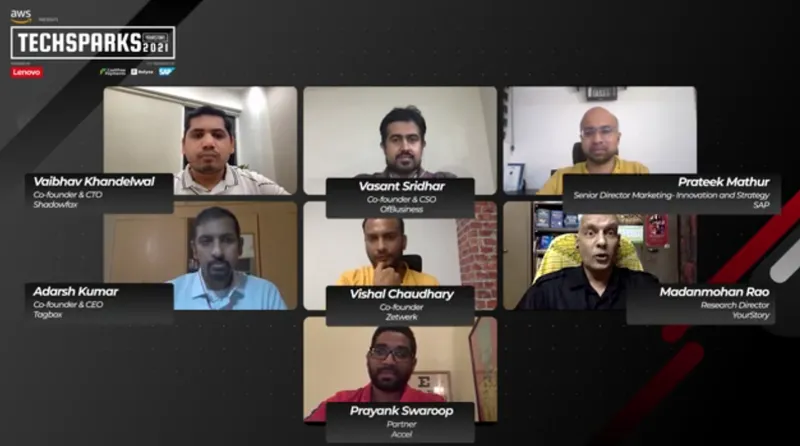India’s SaaS ecosystem is all set to explode, discuss SaaS entrepreneurs at TechSparks 2021
On Day 2 of TechSparks 2021, experts from India’s thriving SaaS landscape discussed the trends, growth and recent developments in the field.
India could be on the cusp of unlocking a $1 trillion opportunity for Software-as-a-Service (SaaS) companies, creating nearly half a million new jobs by 2030, according to a report titled ‘Shaping India’s SaaS Landscape’ by SaaSBOOMi, in association with McKinsey.
Tech talent is one of the major drivers of successful SaaS companies, coupled with the entrepreneurs who have made a mark in the field, shared Vaibhav Khandelwal, Co-founder and CTO, , as he set the context for the panel discussion on ‘Enterprise SaaS: The secret sauce to success’ at TechSparks 2021.
Key drivers for SaaS success
Vasant Sridhar, Co-founder and CSO, , explained that entrepreneurs need to understand that building SaaS in India for the world is entirely different from building SaaS for SMEs.
“If you're building for India, you don't have a large SME base that can pay a lot. If you're building SaaS out of India, you need to layer it with other solutions to maximise the value proposition,” he said.
The secret sauce for SaaS growth for Vishal Chaudhary, Co-founder, , is the rightness of time. “The current time is lucrative with an overall ecosystem showing great examples of success, including regulatory framework,” he shared.
To this, Adarsh Kumar, Co-founder and CEO, , adds that pricing and seamless workflow are both crucial to success. “The ability to make models fungible and flexible is crucial for Indian businesses,” he said.

Adding his view from a VC vantage point, Prayank Swaroop, Partner, Accel Partners, says it is important for entrepreneurs to figure out the trends for global markets.
“Should you go bottoms up first with managers and developers buying your product or should you do enterprise sales teams? That is important,” he said.
But when it comes to SaaS for India, he feels the key lies in patience. “Customers in India take a long time to buy products, so you need to build a relationship. The sophistication in the purchase is not there,” he explained.
SAP’s spokesperson believed the tech-driven ecosystem is the reason why the sector thrived, along with go-to-market strategies.
Innovation strategies made along the way
To grow, enterprises need to constantly innovate and reimagine their services. Vaibhav explained that for Shadowfax, the focus moved to a local distribution setup. As a company that leverages technology like AI to keep pace with demand in the fragmented hyperlocal distribution ecosystem, it focused on speed and started partnering with local players to ensure that fulfilment happened at the right time, across all cities.
The team also decided to uplift the condition of the country’s delivery boys by launching a single one-stop app, their Delivery Super App.
“The benefit of this super app is that you get infinite options to deliver for various brands and it gives you maximum earning potential. It also includes benefits such as insurance. It's a one-stop gateway for blue-collar partners,” Vaibhav said.

OfBusiness became a unicorn this year, but the team made significant changes in their growth plan over the years. In 2015, the startup entered a largely unknown B2B market, catered to small and medium enterprises across sectors like manufacturing, construction, and more recently, launched its lending vertical OXYZO within two years.
Vasant credited this evolution to the trends in the market. On the decision to enter the raw materials space, he explained, “We realised if you're providing raw materials, you need to provide it with some kind of credit term. There is stickiness in credit, great repeat in credit and margin in credit. If you're running a business by providing credit indirectly, you can’t raise equity and give that as working capital.”
Zetwerk entered the unicorn club within three years of launching. But the company was originally launched as a SaaS platform, from where it moved to being a B2B marketplace. Explaining the changes, Vishal said that the team wanted to build software that could help supply chain operators manage their projects efficiently. But while the project managers would love their product, the process would always get delayed when it reached the finance or IT team. And through these processes, it kept hearing one question — can OfBusiness get vendors to their platform?
“That was the first pivot. Then, fulfilment became an issue. That's when we moved to what we do today, which is a managed marketplace. We handhold the supplier and do the entire project management through our in-house software. Our software offers 100 percent transparency, helping them plan better,” Vasant shared.
As the demand for supply chain visibility accelerated during the pandemic, digital logistics solution providers witnessed a boom. TagBox’s Adarsh credits the 3x growth of their revenue during the pandemic to a mix of fortune and flexibility. Their platform for supply chain monitoring leverages IoT, machine learning and artificial intelligence. “We repurposed some of the IoT hardware to be able to do social distancing and contact tracing. We got good traction. SAP helped us scale quickly,” he said.
SAP has been known to be very well suited for large traditional businesses. But of late, a lot of new-age tech-led companies are adopting SAP. SAP believes that when startups become unicorns, it is essential for them to upgrade their technology to fit their new stature. To that end, SAP has been a reliable partner.
“Many B2B startups have started approaching us, finding a better way to integrate with our SAP core system and products. We work with them in taking those solutions along SAP’s core stack to the market. We are seeing tremendous demand from across segments such as manufacturing, supply chain, supply chain finance,” SAP’s spokesperson on the panel said.
To help startups scale in India and globally, SAP has launched Project Nakshatra — a programme for hyper-growth startups — through which SAP brings right-sized packages to help startups run and scale their businesses.
The programme also helps startups align better with the customers' needs by offering them access to the right business and marketing mentorship and incubation programmes.
The next step for India’s SaaS ecosystem
Being the first mover or trendsetter in spaces will be important, according to Vaibhav. “The trend of building SaaS from India for the world will change in the future. While it will grow, there will be a demand for building for India and Asia,” he said.
Vishal added that the coming days will see the use of software as a platform to provide the highest level of reliability and transparency in complex supply chain jobs.
“We need support not just from NASDAQ, but also the Indian stock market,” Prayank added.
SAP’s spokesperson sums up the conversation by saying, “Go for the GLOBE”, where G stands for go-to-market, L for leverage partnership, O for operational excellence, B for best-in-class products, and E for enrol and sign up for Project Nakshatra.
To log in to our virtual events platform and experience TechSparks 2021 with thousands of other startup-tech enthusiasts from around the world, join here. Don't forget to tag #TechSparks2021 when you share your experience, learnings and favourite moments from TechSparks 2021.
For a line-up of all the action-packed sessions at YourStory's flagship startup-tech conference, check out TechSparks 2021 website.










